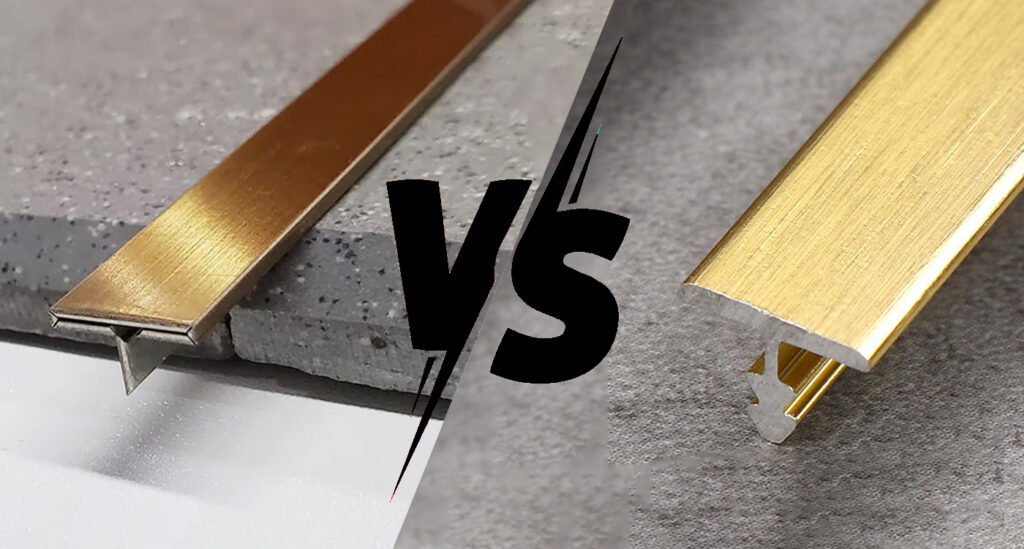Stainless Steel Trims VS. Aluminum Trims
Table of Contents
Stainless steel baseboards are an excellent option for people who prefer sleek, contemporary designs for their interior spaces. They serve both a practical and aesthetic purpose in that they protect the base of walls from damage, as well as adding a stylish touch to the room. In this article, we will examine the key features, benefits, and installation process involved in using stainless steel baseboards.
Stainless Steel Trims
Stainless steel trims are known for its durability and corrosion resistance, making it an ideal choice for high-traffic areas or applications that require extended durability. Stainless steel decorative trims are designed to maintain their visual appeal and performance, even with regular exposure to harsh conditions, such as moisture and temperature fluctuations.
Additionally, stainless steel trim offers an excellent range of finishes, including brushed, polished, and satin, allowing designers and homeowners to create the perfect look for their space. However, stainless steel trim can be more expensive than aluminum trim, and it can be heavy, which requires extra support during the installation process.
Aluminum Trims
Aluminum decorative trim is a popular alternative for those who desire a lightweight, low-cost, and relatively malleable material. Aluminum trim is highly versatile, making it a good option for a wide range of applications. Additionally, aluminum is resistant to rust and corrosion, allowing it to retain its appearance and function over time.
Furthermore, aluminum trims are available in a wide range of colors and finishes, and they are easier to install than stainless steel trims. However, aluminum trim is more susceptible to dings and scratches than stainless steel, can appear less visually appealing than stainless steel, and is not as sturdy as stainless steel when it comes to heavy wear and tear.
Stainless Steel vs. Aluminum Trims: Best Usage Environment
When selecting between stainless steel trims and aluminum trims, the usage environment is essential to consider. Stainless steel is a better choice than aluminum decorative profile for high-traffic areas or applications where durability and longevity are critical. For instance, stainless steel is ideal for poolsides, decks, and patios, where exposure to moisture, UV rays, and other damaging elements is commonplace. On the other hand, aluminum trim is a better option for low-traffic areas that may not require as much durability and strength. For example, an aluminum edge trim could be the right choice for wallpaper borders, showrooms, or other areas that do not experience a lot of wear and tear.

Distinguish Stainless Steel Trim & Aluminum Trims
Appearance
Stainless steel tile trim has a shiny and reflective surface, while aluminum tile trim has a matte or brushed finish.
Weight
Stainless steel tile trim is heavier than aluminum tile trim. You can compare the weight of the two materials to determine which one you have.
Corrosion resistance
Stainless steel is highly resistant to corrosion, making it suitable for areas with high moisture or humidity. Aluminum is also corrosion-resistant but may not be as durable as stainless steel in certain environments.
Price
Stainless steel tile trim is generally more expensive than aluminum tile trim due to its higher durability and corrosion resistance.
Maintenance
Take accurate measurements of the wall area to help you size and estimate how much baseboard to purchase.
Application
Consider the specific application of the tile trim. Stainless steel is often used in commercial or high-end residential settings where durability and aesthetics are important. Aluminum is commonly used in residential projects or areas where cost-effectiveness is a priority.


Practical Suggestions for Choosing Decorative Trim Materials
If you are considering a decorative trim purchase, here are some practical suggestions to make an informed decision:
Consider the usage environment
Choose a trim suitable for the environment it will be installed in. If exposed to harsh environments or heavy wear and tear, select stainless steel.
Think about the budget
Stainless steel trim is typically more expensive. However, it may offer cost savings in the long run due to its durability and longevity. Determine your project's budget and what material options can fit within it.
Choose the right finish
Evaluate finishes offered in both product lines, and pick the one that best matches the interior design style.
Get professional installation help
Get professional help during installation to ensure material handling and proper installation techniques are used to avoid issues like the trim wobbling or coming loose.
Final Thoughts
Stainless steel trims and aluminum trims offer unique advantages and limitations for specific applications. For high traffic areas, such as public spaces, poolsides, and decks, stainless steel is the better choice due to its durability, longevity, and resistance to harsh conditions. Conversely, aluminum decorative trim is a good alternative for low traffic interior applications that require a low-cost alternative. Consider usage environment, budget, and finishes offered when choosing a decorative trim material. Selecting the material best suited to requirements results in durable, stable, and aesthetically pleasing results for years to come.
You Might Also Like
Please Share This
Follow Us On Twitter
On-site Installation of Stainless Steel Screen Partition
Precision-made. Professionally installed.
Transforming spaces with durable, elegant metal dividers.
📮DM us for custom design and project support.
#interiordecoration #metalpartition #roomdivider #sheetmetalfab
Café Design | A Sensory Collision of Metal and Coffee
This design is from BOUNDLESS SPACE DESIGN OFFICE
If you are interested in stainless steel decorative materials, please contact me for a quote !
Email: claire@jyfmetal.com
#interiordecoration #decorativematerials #metallic
Stainless Steel Fluted Panels & Skirting Boards
Clean lines, large size, premium finish — perfect for luxury interiors.
Custom colors, surface treatments, and dimensions available.
📩 DM us for catalogs or project solutions.
#flutedpanels #metalskirting




